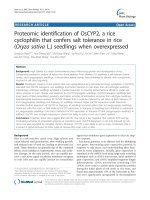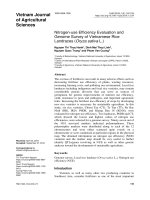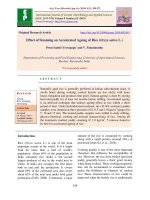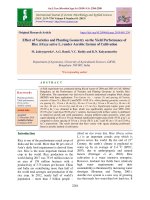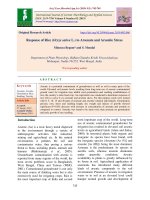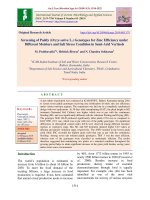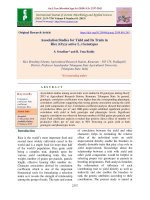Evaluation of test crosses for identification of potential restorers and maintainers for development of rice hybrids (Oryza sativa L.)
Bạn đang xem bản rút gọn của tài liệu. Xem và tải ngay bản đầy đủ của tài liệu tại đây (237.83 KB, 6 trang )
Int.J.Curr.Microbiol.App.Sci (2019) 8(2): 1146-1151
International Journal of Current Microbiology and Applied Sciences
ISSN: 2319-7706 Volume 8 Number 02 (2019)
Journal homepage:
Original Research Article
/>
Evaluation of Test Crosses for Identification of Potential Restorers and
Maintainers for Development of Rice Hybrids (Oryza sativa L.)
K. Parimala1*, Ch. Surender Raju2, A.S. Hari Prasad3, S. Sudheer Kumar4,
S. Narender Reddy5 and M.H.V. Bhave5
1
Seed Research and Technology Centre, PJTSAU, Rajendranagar, Hyderabad -30, India
2
Rice Research Centre, Rajendranagar, Hyderabad -30, India
3
ICAR-Indian Institute of Rice Research, Rajendranagar, Hyderabad -30, India
4
PJTSAU, Rajendranagar, Hyderabad -30, India
5
College of Agriculture, PJTSAU, Rajendranagar, Hyderabad -30, India
*Corresponding author
ABSTRACT
Keywords
Rice Hybrids,
(Oryza sativa L.),
Evaluation of Test
Crosses
Article Info
Accepted:
10 January 2019
Available Online:
10 February 2019
The investigation was carried out to identify the potential maintainers and restorers in rice
by crossing the one CMS line with 65 selected genotypes during rabi 2012-13. The
resultant 65 test crosses were evaluated during kharif 2013. A high range of spikelet
fertility was recorded among the hybrids i.e., from 0 to 92.4 per cent which indicated that
restorability varies depending on male parent. Among the 65 test crosses studied, 28
genotypes exhibited high spikelet fertility (>75%), 20 were partial fertile (50 to 75 %),
whereas 14 genotypes were partial maintainers (1 to 50 %) and three genotypes were
found to be completely sterile (0 %). The identified maintainers can be developed as new
cytoplasmic male sterile lines by repeated back cross breeding with recurrent parent.
Among the 28 restorers identified, 12 best restorers with more than 80 per cent spikelet
fertility were selected for further use in hybrid rice breeding.
Introduction
The development and use of hybrid rice
varieties on commercial scale using male
sterility and fertility restoration system has
proved to be a breakthrough in rice
improvement. The availability of stable
cytoplasmic male sterility and fertility
restoring system is vital for commercial
exploitation of heterosis in rice. Cytoplasmic
genetic male sterile lines introduced from
elsewhere may not be well adapted to a given
target area. Successful use of hybrid vigour in
rice largely depends on the availability of
locally developed cytoplasmic genetic male
sterile and restorer lines (Kumar et al., 1996).
Identification of locally adapted maintainers
and restorers which show complete sterility
and consistently high degree of restoration of
CMS lines would be of great value in
commercial hybrid programme, if restoring
ability is combined with high combining
ability. Earlier researchers viz., Hussain and
Sanghera (2012); Singh et al., (2013);
1146
Int.J.Curr.Microbiol.App.Sci (2019) 8(2): 1146-1151
Veeresha et al., (2013); Bhati et al., (2014);
Parmeshwar Kumar et al., (2014); Jamil
Hasan et al., (2015); Pankaj Kumar et al.,
(2015) and Ramesh et al., (2018) evaluated
the test crosses in rice to identify the restorer
and maintainer reaction and reported varying
levels of pollen and spikelet fertility
percentage. The establishment of test cross
nursery to identify restorers and maintainers
is the first step in three line heterosis breeding
(Akhter et al., 2008). Use of male sterility
system would be appropriate approach for
commercial exploitation of heterosis in rice.
In view of the above, the present study was
conducted to identify the effective fertility
restorers and maintainers.
The resultant 65 test crosses were evaluated in
test cross nursery during kharif, 2013. Pollen
fertility test was carried out by using the five
randomly selected spikelets from each entry.
With the help of forceps, the anthers from the
spikelets were gently placed on glass slide
containing 2% Iodine Potassium Iodide (IKI)
solution. Then the anthers were gently
crushed to release the pollen grains and
observed under microscope. The pollen
fertility (%) was calculated by using the
formula as given below:
No. of fertile
pollen grains
x 100
Pollen fertility (%) =
Total No. of
pollen grains
Materials and Methods
Five panicles were selected randomly from
each entry during maturity and spikelet
fertility (%) was calculated by using the
following formula:
No. of filled
grains/panicle
x 100
Spikelet fertility (%) = Total No. of
grains/panicle
The basic material for the study consists of
one cytoplasmic male sterile (CMS) line of
IR-79156A and 65 elite rice genotypes
obtained from germplasm collection of Rice
Research Centre, Rajendranagar, Hyderabad.
The CMS line IR-79156A was crossed with
65 diverse male fertile genotypes during rabi,
2012-13. In a crossing block, one CMS line
(IR-79156A) and 65 elite rice genotypes were
transplanted with a spacing of 20 x 15 cm in a
row of 6 m length in three staggered sowings.
The following criteria for classifying the
pollen parents were used as proposed by
(Virmani et al., 1997).
Category
Healthy male sterile plant with just emerged
panicles were uprooted and potted into plastic
buckets filled with mud and were transferred
to the crossing chamber. Healthy panicles
with florets expected to open on the next day
were used for crossing. Top 1/3rd portion of
each floret was clipped with scissors during
evening hours and covered with butter paper
bags. Next day morning, panicles ready for
anthesis were collected from male parents and
used for pollination with CMS lines (female
parent). The pollinated spikelets were then
covered and labelled. Crossed seeds were
collected after four weeks and seeds were
dried and preserved.
Pollen
Spikelet
fertility (%) fertility (%)
Maintainers
0-1
0
Partial
1.1-50
0.1-50
maintainers
Partial
50.1-80
50.1-75
restorers
Restorers
>80
>75
Results and Discussion
A total of 65 test crosses were evaluated for
fertility restorer and maintainer reaction. The
performance of the hybrids in test cross
nursery for fertility restoration is presented in
Table 1. The pollen fertility of hybrids varied
1147
Int.J.Curr.Microbiol.App.Sci (2019) 8(2): 1146-1151
from 0.2 % (IR-79156A x WGL-13400) to
94.2% (IR-79156A x RNR-2456). A high
range of spikelet fertility was recorded among
the hybrids i.e., from 0 to 92.4 per cent which
indicated that restorability varies depending
on male parent. Among the 65 test crosses
studied, 28 genotypes considered as restorers
which exhibited high spikelet fertility
(>75%), 20 genotypes found to be partial
fertile (50 to 75 %), whereas, 14 genotypes
were partial maintainers (1 to 50 %) and three
genotypes (IR-79156A x JGL-11727, IR-
79156A x Sumathi and IR-79156A x WGL13400) showed complete spikelet sterility (0
%). Ali et al., (2014); Pankaj Kumar et al.,
(2015) and Srijan et al., (2015) reported that
fertility restoration reaction of the genotypes
varies with genetic background of CMS lines.
Umadevi et al., (2010) also reported that this
variation may be due to the pollen fertility /
restoring genes differ or their penetrance or
expressivity differed with genotypes or due to
existence of modifiers genes.
Table.1 Fertility restoration study for identification of restorers and maintainers in rice
S.No.
1
2
3
4
5
6
7
8
9
10
11
12
13
14
15
16
17
18
19
20
21
22
23
24
25
26
Crosses
IR-79156A x RNR-17462
IR-79156A x RNR-15351
IR-79156A x RNR-6378
IR-79156A x RNR-15038
IR-79156A x WGL-583
IR-79156A x WGL-48684
IR-79156A x NLR-33358
IR-79156A x RNR-883
IR-79156A x RNR-2456
IR-79156A x 6527
IR-79156A x WGL-451
IR-79156A x RNR-17473
IR-79156A x WGL-3962
IR-79156A x WGL-347
IR-79156A x NLR-3042
IR-79156A x RNR-15398
IR-79156A x RNR-2781
IR-79156A x IR-83142-B-57-B
IR-79156A x D-4098
IR-79156A x WGL-14
IR-79156A x RNR-2458
IR-79156A x RNR-15048
IR-79156A x RNR-15028
IR-79156A x NWGR-3132
IR-79156A x MTU-1081
IR-79156A x RNR-2465
Days to
50%
flowering
Pollen
fertility
(%)
No. of
unfilled
grains /
panicle
No. of
filled
grains /
panicle
Spikelet
fertility
(%)
Fertility
reaction
90
99
99
91
100
92
81
113
100
94
89
92
90
92
88
99
91
91
91
93
92
99
90
97
89
100
89.5
85.4
82.6
92.8
86.0
84.3
80.7
87.5
94.2
86.1
90.2
82.5
86.3
88.4
90.0
83.9
91.5
84.9
90.5
83.7
89.3
87.9
93.5
86.7
90.0
92.5
19.7
19.5
19.8
23.5
18.6
19.1
20.7
19.7
21.0
23.3
16.7
18.0
28.6
31.2
28.6
29.5
36.5
36.1
29.7
32.6
35.6
36.7
36.5
42.5
26.7
23.7
239.4
235.4
221.5
258.3
183.3
184.7
192.5
175.6
189.7
195.4
135.7
142.3
216.4
219.2
198.4
201.6
245.7
238.4
184.8
198.5
208.2
215.0
204.9
254.9
136.4
118.0
92.4
92.3
91.8
91.7
90.8
90.6
90.3
89.9
90.0
89.3
89.1
88.8
88.3
87.5
87.4
87.2
87.1
86.8
86.2
85.9
85.4
85.4
84.9
85.7
83.6
83.3
R
R
R
R
R
R
R
R
R
R
R
R
R
R
R
R
R
R
R
R
R
R
R
R
R
R
1148
Int.J.Curr.Microbiol.App.Sci (2019) 8(2): 1146-1151
27
28
29
30
31
32
33
34
35
36
37
38
39
40
41
42
43
44
45
46
47
48
49
50
51
52
53
54
55
56
57
58
59
60
61
62
63
64
65
R-Restorer,
IR-79156A x Vajram
IR-79156A x Akshayadhan
IR-79156A x Zhonghuai
IR-79156A x IR-83142-B-21-B
IR-79156A x NP-6226
IR-79156A x JGL-1798
IR-79156A x RNR-10291
IR-79156A x JGL-11470
IR-79156A x NLR-40058
IR-79156A x RNR-17438
IR-79156A x NLR-145
IR-79156A x MGD-103
IR-79156A x IR-64
IR-79156A x RNR-898
IR-79156A x C-26
IR-79156A x RNR-17420
IR-79156A x RNR-17494
IR-79156A x RNR-17472
IR-79156A x NSN-20114
IR-79156A x NPG-210
IR-79156A x TCA-80-A
IR-79156A x JGL-11118
IR-79156A x Pushyami
IR-79156A x P-35
IR-79156A x Champakali
IR-79156A x IR-83142-B-61-B
IR-79156A x RNR-11636
IR-79156A x NSN-20894
IR-79156A x JGL-11690
IR-79156A x Dembersali
IR-79156A x HonneKattu
IR-79156A x CT-18664-9-10-5-6-3
IR-79156A x CSR-23
IR-79156A x IR-79216-141-1-3-3-3
IR-79156A x WGL-20471
IR-79156A x JGL-384
IR-79156A x JGL-11727
IR-79156A x Sumathi
IR-79156A x WGL-13400
PR-Partial Restorer,
90
95
93
87
102
102
97
108
93
89
94
94
104
99
82
102
92
96
79
94
94
94
97
91
90
91
93
102
82
88
81
100
93
99
107
106
112
104
102
85.2
86.9
72.6
79.6
82.0
62.5
84.6
71.9
86.4
68.2
50.0
83.4
50.0
55.0
61.8
56.3
73.5
59.4
52.0
64.8
73.5
38.6
68.9
42.5
56.9
34.4
35.2
43.6
23.4
42.5
17.5
40.5
17.2
1.6
1.5
0.5
1.0
0.5
0.2
56.4
60.1
55.6
58.2
62.8
64.5
56.4
48.2
58.4
53.4
62.7
29.7
53.7
79.3
66.7
61.5
95.6
74.8
92.2
102.4
116.7
107.6
133.7
171.9
87.7
163.7
95.6
182.4
66.7
116.7
224.5
133.3
123.4
127.6
128.6
142.0
114.6
125.6
137.6
203.5
182.4
159.6
166.7
175.9
179.8
154.6
132.0
159.6
145.0
169.0
78.7
132.7
184.6
153.3
124.6
184.6
143.2
148.7
124.5
126.3
112.9
122.8
110.5
47.7
83.9
36.8
64.5
19.4
16.0
26.7
15.7
5.0
3.0
3.0
2.0
0.0
0.0
0.0
78.3
75.2
74.2
74.1
73.7
73.6
73.3
73.3
73.2
73.1
72.9
72.6
71.2
70.0
69.7
67.0
65.9
65.7
61.7
54.9
52.0
51.2
47.9
39.1
35.2
33.9
27.8
26.1
22.5
12.1
10.6
10.5
3.9
2.3
2.3
1.4
0.0
0.0
0.0
PM-Partial Maintainer,M-Maintainer
Akhter et al., (2008) observed higher
frequency of maintainers (17%) than that of
restorers (11%) in their studies. Hence, more
emphasis should be given to utilize popular
rice cultivars in hybrid rice breeding as
parental lines to achieve the goal of superior
1149
R
R
PR
PR
PR
PR
PR
PR
PR
PR
PR
PR
PR
PR
PR
PR
PR
PR
PR
PR
PR
PR
PM
PM
PM
PM
PM
PM
PM
PM
PM
PM
PM
PM
PM
PM
M
M
M
Int.J.Curr.Microbiol.App.Sci (2019) 8(2): 1146-1151
hybrids. Among the 28 restorers, 12
genotypes were found to be good with more
than 80 per cent fertility restorability (RNR15351, WGL-3962, IR-83142-B-57-B, RNR15398, D-4098, NWGR-3132, RNR-15028,
RNR-15038, RNR-2458, RNR-2456, RNR17462 and RNR-2781). In addition to spikelet
fertility the characters like pollen fertility (%),
flowering duration, plant stature and number
of filled grains per panicle were taken into
consideration while selection of restorers. The
hybrids IR-79156A x RNR-2781, IR-79156A
x NWGR-3132 and IR-79156A x RNR-15038
exhibited more number of filled grains per
panicle. The identified maintainers can be
developed as new cytoplasmic male sterile
lines by repeated back cross breeding. Twelve
good restorer lines found in this study could
be utilized as pollen parent for the
development of new rice hybrids.
References
Akhter, M., Zahid, M.A., Sabar, M. and
Ahmad, M. 2008. Identification of
restorers and maintainers for the
development of rice hybrids. Journal
of Animal and Plant Science, 18(1):
39-41.
Ali, M., Hossain, M.A., Hasan, M.J. and
Kabir, M.E. 2014. Identification of
maintainer and restorer lines in local
aromatic rice (Oryza sativa L.).
Bangladesh Journal of Agricultural
Research, 39(1): 1-12.
Bhati, P.K., Singh, S.K., Amita Sharma and
Dhurai, S.Y. 2014. Identification of
restorers and maintainers for different
‘WA’ CMS lines in rice (Oryza sativa
L.). Research in Environment and Life
Sciences, 7(1):53-56.
Hussain, W. and Sanghera, G.S. 2012.
Exploitation of heterosis in rice
(Oryza sativa L.) using CMS system
under temperate conditions. Electronic
Journal of Plant Breeding. 3(1):6951150
700.
Jamil Hasan Md, Umma Kulsum, Niaz Md,
Farhat Rahman, Tonima Farhat and
Abubakar Siddique Md. 2015. Hybrid
rice parental lines development
utilizing different rice germplasms.
Advances in Environmental Biology,
9(2):24-29.
Kumar, R.V., Satyanarayana, P. V. and Rao,
M.S. 1996. New cytoplasmic male
sterile lines developed in Andhra
Pradesh, India. International Rice
Research Notes, 21(2-3):30.
Pankaj Kumar, Vinay Kumar Sharma and
Bishun
Deo
Prasad.
2015.
Characterization of maintainer and
restorer lines for wild abortive
cytoplasmic male sterility in indica
rice (Oryza sativa L.) using pollen
fertility and microsatellite (SSR)
markers. Australian Journal of Crop
Science, 9(5): 384-393.
Parmeshwar Kumar Sahu, Pooja Sahu,
Satyapal Singh, Tarun Singh Patel and
Deepak Sharma. 2014. Identification
of restorers and maintainers for
development of rice hybrids using WA
and Kalinga sources of CMS lines.
Electronic Journal of Plant Breeding,
5(4):752-755.
Ramesh, Ch., Damodar Raju Ch., Surender
Raju Ch. and Rama Gopala Varma, N.
2018. Spikelet fertility restoration
studies for identification of restorers
and maintainers in rice (Oryza sativa
L.). Research Journal of Agricultural
Sciences, 6(4): 751-753
Singh, S.K., VikasSahu, Amita Sharma and
Bhati, P.K. 2013. Identification of
restorers and maintainers for different
wild abortive CMS lines in rice
(Oryza sativa L.). Research in
Environment and Life Sciences.
6(4):119-120.
Srijan, A., Sudheer Kumar, S., Damodar
Raju, Ch. and Jagadeeshwar, R. 2015.
Int.J.Curr.Microbiol.App.Sci (2019) 8(2): 1146-1151
Pollen and spikelet fertility studies for
the identification of good restorers and
maintainers in rice (Oryza sativa L.).
Int.J.Curr.Microbiol.App.Sci.,
7(3):
942-945.
Umadevi,
M.,
Veerabadhiran,
P.,
Manonmani,
S
and
Shanmugasundaram,
P.
2010.
Identification of potential maintainers
and restorers using cytoplasmic male
sterile lines in rice. Electronic Journal
of Plant Breeding, 1(4): 948-952.
Veeresha,
B.A.,
Hanamaratti,
N.G.,
Salimath, P.M. and Chetti, M.B. 2013.
Identification of restorers and
maintainers for development of rice
hybrids. Bioinfolet, 10(2B):602-606.
Virmani, S.S., Viraktamath, B.C., Casal,
C.L., Toledo, R.S., Lopez, M.T and
Manalo, J.O. 1997. Hybrid rice
breeding manual, International Rice
Research Institute, Philippines.
How to cite this article:
Parimala, K., Ch. Surender Raju, A.S. Hari Prasad, S. Sudheer Kumar, S. Narender Reddy and
Bhave, M.H.V. 2019. Evaluation of Test Crosses for Identification of Potential Restorers and
Maintainers for Development of Rice Hybrids (Oryza sativa L.). Int.J.Curr.Microbiol.App.Sci.
8(02): 1146-1151. doi: />
1151
